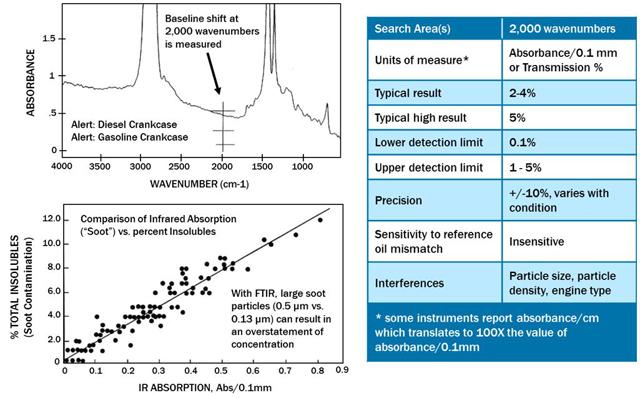How to Detect Soot in Diesel Oil
 "What is the best method to detect soot in diesel oil? Our labs use Fourier transform infrared (FTIR) spectroscopy as a primary means of measuring soot in used diesel engine oils. I have been told that viscosity at 40 degrees C is a good indicator as well. Which instruments or methods will give me the most accurate soot level?"
"What is the best method to detect soot in diesel oil? Our labs use Fourier transform infrared (FTIR) spectroscopy as a primary means of measuring soot in used diesel engine oils. I have been told that viscosity at 40 degrees C is a good indicator as well. Which instruments or methods will give me the most accurate soot level?"
There are several available tests that can detect soot load in diesel oil. As a screen test with a lower cost, FTIR is a great indicator of soot.
It is capable of measuring more than a dozen parameters, with some more reliable than others depending on the susceptibility to interference in the established wavenumber region.
While the data collection is relatively easy, there are challenges with measurement accuracy, especially as the size of the soot particles increases and constituents like dirt are included.
The maximum detection limit can range from 1.5 to 5 percent. This is concerning since the critical limits for engines with exhaust gas recirculation (EGR) may be 8 percent, and non-EGR systems may be around 5 percent.

Other alternatives include the pentane insolubles test, the light extinction method and thermogravimetric analysis. The pentane insolubles test consists of separating insolubles from the oil with the aid of a solvent mixed with the lubricant.
The solvent may commonly be pentane and toluene. The insolubles are flung out of the mixture with a centrifuge or filtered out with a filter membrane. While this is a preferred method with a lower cost, it poses concerns when other insolubles are included, as they will be measured together.
The light extinction method involves light being casted at specific frequencies through the oil and then measuring its obstruction by the drop in voltage. Again, there are some issues with this method related to other potential objects obstructing the light, even water and air bubbles.
Thermogravimetric analysis may be the most accurate measurements of soot load in an oil sample. It requires heating a sample through different stages to calculate the soot concentration by comparing the difference in weight of the volatile ash components to the original sample.
This test may have a much higher cost, so it is not a viable substitution for routine tests. Nevertheless, it is perfectly acceptable for exception testing after a screening test has been performed.
Soot dispersancy is an important lubricant property. It is defined as the lubricant's ability to keep soot particles finely dispersed and avoid agglomeration into larger soot particles.
This can be measured with a simple method known as the blotter spot test, which allows for a visual representation of the soot's dispersancy.



_extra_large.jpeg)

